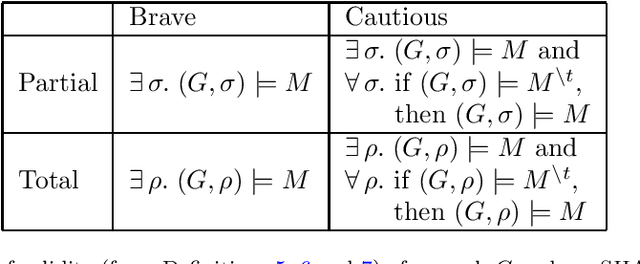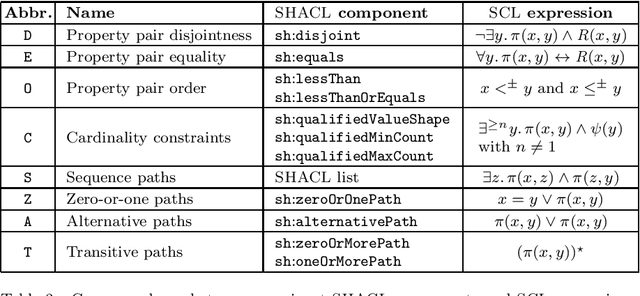Fabio Mogavero
Satisfiability and Containment of Recursive SHACL
Aug 30, 2021



Abstract:The Shapes Constraint Language (SHACL) is the recent W3C recommendation language for validating RDF data, by verifying certain shapes on graphs. Previous work has largely focused on the validation problem and the standard decision problems of satisfiability and containment, crucial for design and optimisation purposes, have only been investigated for simplified versions of SHACL. Moreover, the SHACL specification does not define the semantics of recursively-defined constraints, which led to several alternative recursive semantics being proposed in the literature. The interaction between these different semantics and important decision problems has not been investigated yet. In this article we provide a comprehensive study of the different features of SHACL, by providing a translation to a new first-order language, called SCL, that precisely captures the semantics of SHACL. We also present MSCL, a second-order extension of SCL, which allows us to define, in a single formal logic framework, the main recursive semantics of SHACL. Within this language we also provide an effective treatment of filter constraints which are often neglected in the related literature. Using this logic we provide a detailed map of (un)decidability and complexity results for the satisfiability and containment decision problems for different SHACL fragments. Notably, we prove that both problems are undecidable for the full language, but we present decidable combinations of interesting features, even in the face of recursion.
SHACL Satisfiability and Containment (Extended Paper)
Aug 31, 2020Abstract:The Shapes Constraint Language (SHACL) is a recent W3C recommendation language for validating RDF data. Specifically, SHACL documents are collections of constraints that enforce particular shapes on an RDF graph. Previous work on the topic has provided theoretical and practical results for the validation problem, but did not consider the standard decision problems of satisfiability and containment, which are crucial for verifying the feasibility of the constraints and important for design and optimization purposes. In this paper, we undertake a thorough study of different features of non-recursive SHACL by providing a translation to a new first-order language, called SCL, that precisely captures the semantics of SHACL w.r.t. satisfiability and containment. We study the interaction of SHACL features in this logic and provide the detailed map of decidability and complexity results of the aforementioned decision problems for different SHACL sublanguages. Notably, we prove that both problems are undecidable for the full language, but we present decidable combinations of interesting features.
 Add to Chrome
Add to Chrome Add to Firefox
Add to Firefox Add to Edge
Add to Edge